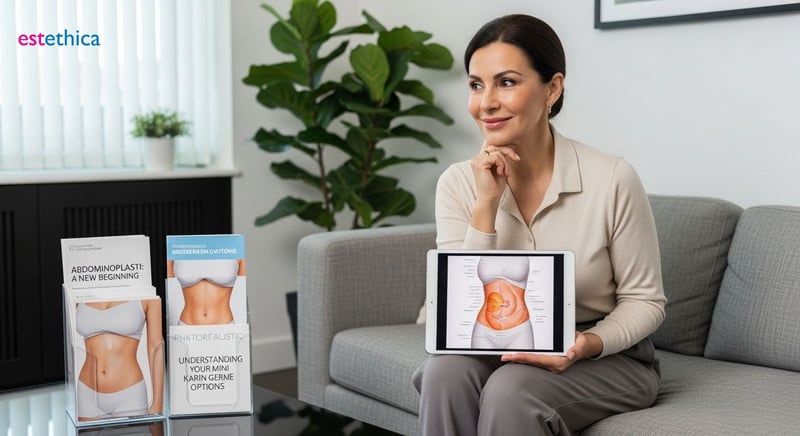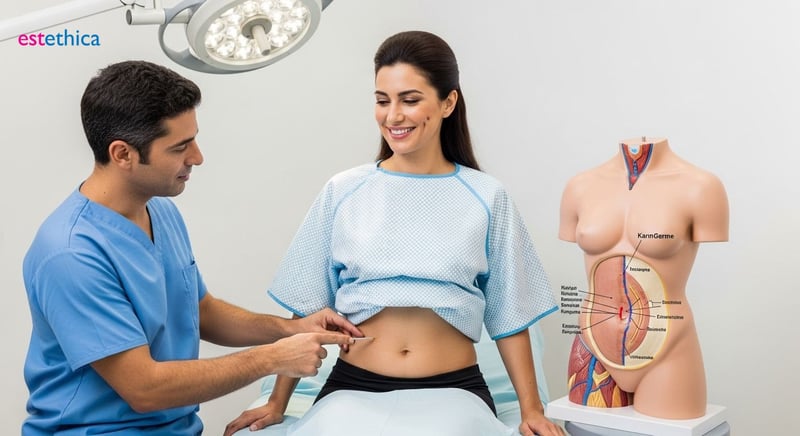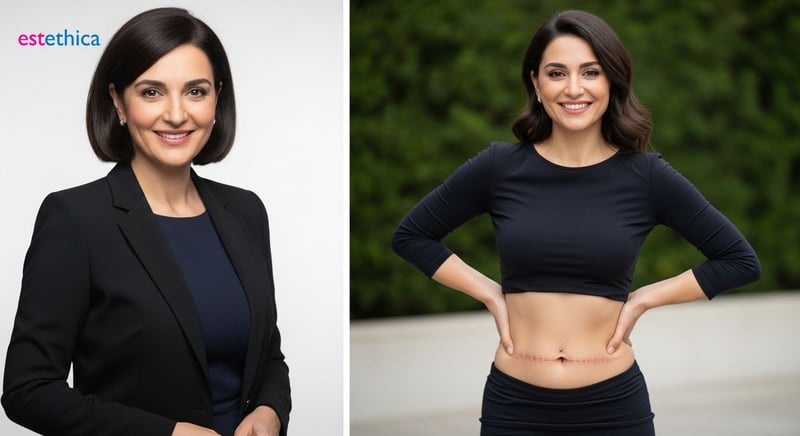Tummy Tuck Surgery: Transform Your Body with Abdominoplasty
Discover the benefits of abdominoplasty for achieving a sculpted abdomen. Learn about the tummy tuck procedure, recovery, and how to choose a qualified surgeon.
Understanding Abdominoplasty: What is a Tummy Tuck?
An abdominoplasty, more commonly known as a tummy tuck, is a surgical procedure designed to enhance the appearance of the abdominal area. Performed by experienced plastic surgeons, this operation addresses issues such as excess, sagging skin and localized fat deposits that can accumulate due to various life events. Factors like significant weight loss, the natural aging process, or multiple pregnancies can leave the abdominal skin and muscles lax, impacting the overall contour of the midsection.
The Core of Tummy Tuck Surgery
During a tummy tuck, the surgeon meticulously tightens the underlying abdominal muscles, particularly addressing diastasis recti – the separation of the abdominal muscles. This muscle repair is crucial for creating a flatter, firmer profile. Following muscle restoration, the excess skin is carefully removed, and the remaining skin is repositioned and sutured, resulting in a smoother and more toned abdominal appearance. It is important to understand that this procedure is fundamentally a body-contouring treatment, not a method for substantial weight reduction. Individuals typically opt for abdominoplasty when they have achieved a stable body weight and are seeking to correct specific aesthetic concerns related to their abdomen that cannot be resolved through diet or exercise alone.
Who is a Good Candidate for Abdominoplasty?
Ideal candidates for abdominoplasty are generally healthy individuals who have realistic expectations about the outcomes of the surgery. They often have a stable weight and are bothered by loose skin or a protruding abdomen that diet and exercise haven't managed to fix. This can include individuals who have experienced massive weight loss and are left with significant skin laxity, or women who have had children and wish to restore their pre-pregnancy figure. While a tummy tuck is primarily focused on the abdomen, some individuals may also consider complementary procedures. For instance, those interested in enhancing other areas of their physique might find information on Breast Augmentation: Your Guide to Breast Enlargement Surgery to be of interest for a more comprehensive body transformation. The decision to undergo abdominoplasty should be made after a thorough consultation with a qualified surgeon to discuss individual goals, medical history, and the potential risks and benefits associated with the tummy tuck.

Full Abdominoplasty vs. Mini Tummy Tuck: Procedure Differences
Deciding between a full abdominoplasty and a mini tummy tuck is a crucial step in achieving your desired aesthetic outcome. The primary distinction lies in the extent of correction required and the areas of the abdomen addressed. Understanding these procedural differences is key to making an informed choice, and effective Plastic Surgery Marketing: Elevate Your Aesthetic Practice can help potential patients navigate these options.
Full Abdominoplasty: Comprehensive Correction
A full abdominoplasty, often referred to as a complete tummy tuck, is designed for individuals with significant excess skin and muscle laxity across the entire abdominal region. This comprehensive procedure typically involves an incision that extends from one hip bone to the other, curving up towards the belly button. During a full abdominoplasty, the surgeon can effectively remove a substantial amount of sagging skin, both above and below the navel. Furthermore, the abdominal muscles, which may have become separated or weakened over time (a condition known as diastasis recti), are tightened and repaired from the rib cage down to the pubic area. The belly button is also repositioned as part of this extensive reconstruction, resulting in a flatter, firmer, and more contoured abdominal profile.
Mini Tummy Tuck: Targeted Improvement
Conversely, a mini tummy tuck is a less invasive option suited for individuals who primarily have excess skin and mild laxity concentrated in the lower abdomen, below the belly button. The incision for a mini tummy tuck is generally shorter than that of a full abdominoplasty and does not typically extend from hip to hip. While muscle tightening can still be performed in the lower abdominal area, it is usually focused on this specific region and does not extend as high as in a full procedure. A key difference is that the belly button is typically not moved or repositioned during a mini tummy tuck. This makes it an excellent choice for those who don't require extensive muscle repair or a complete reshaping of the entire abdominal wall. Both types of tummy tuck surgery offer transformative results, but the specific needs of the patient dictate which procedure is most appropriate.
Tummy Tuck Recovery Time: What to Expect After Surgery
Undergoing a tummy tuck is a significant step towards achieving your aesthetic goals, but the journey doesn't end with the surgery itself. The recovery period following an abdominoplasty is a critical phase that requires patience, careful attention, and strict adherence to your surgeon's post-operative instructions. Understanding what to expect during this time can help manage expectations and ensure a smoother healing process.
Immediately after your tummy tuck surgery, you will likely experience some discomfort, swelling, and bruising. Pain medication will be prescribed to manage any discomfort effectively. You will also be fitted with a compression garment. This is a vital piece of equipment designed to support the healing tissues, minimize swelling, and help your skin retract smoothly over your new contours. It's crucial to wear this garment as directed by your surgeon, typically for several weeks.
The Initial Weeks of Recovery
The first few days post-operation are typically the most challenging. You'll need to rest and avoid strenuous activities. Most patients find they can return to light daily activities within one to two weeks. This might include short walks, which are actually encouraged to aid circulation and reduce the risk of blood clots. However, any activity that puts strain on your abdominal muscles, such as heavy lifting, intense exercise, or even prolonged sitting, should be strictly avoided for at least four to six weeks. It's also important to sleep in a slightly elevated position to reduce pressure on the incision site.
As you progress through your recovery, you'll notice the swelling gradually subsiding and the bruising fading. While you might start to see initial results relatively quickly, the final outcome of your tummy tuck will continue to evolve for several months. Full recovery, where the swelling has significantly reduced and you can fully appreciate the results of your procedure, typically takes anywhere from three to six months, and sometimes longer. This healing timeline is comparable to other major cosmetic procedures; for instance, those considering Rhinoplasty: Achieve Your Ideal Nose Shape with Expert Nose Surgery often find that the weeks and months following their procedure require similar patience for optimal results.
Preparing for Your Recovery
A crucial aspect of a successful recovery is preparation. Ensure you have adequate support at home, whether from family or friends, to assist you with daily tasks during the initial recovery period. Scheduling sufficient time off work is also essential – plan for at least two weeks, depending on the nature of your job. Having a designated support system and allowing your body the time it needs to heal properly are paramount after undergoing a tummy tuck.

Find the Best Tummy Tuck Surgeon for Your Transformation
Embarking on the journey to achieve a more sculpted and confident physique through a tummy tuck procedure is a significant decision. While the results can be transformative, the key to a safe and successful outcome lies in selecting the right plastic surgeon. This is not a choice to be rushed, as your health, safety, and aesthetic satisfaction depend on it. A highly skilled and experienced surgeon is your most valuable asset in achieving your desired body contouring goals.
Expertise and Experience are Paramount
When seeking a surgeon for your abdominoplasty, prioritize board certification in plastic surgery. This designation ensures that the surgeon has met rigorous standards of training, ethics, and proficiency. Beyond certification, look for extensive experience specifically in performing tummy tuck procedures. Many surgeons offer a range of cosmetic surgeries, but specialization in body contouring, particularly this procedure, is crucial. Their familiarity with various patient anatomies and potential challenges will directly impact the quality of your results and the safety of the surgery. Don't hesitate to inquire about the number of tummy tuck surgeries they perform annually and their specific approach to techniques like muscle repair and skin tightening.
Assessing Surgical Outcomes and Patient Satisfaction
One of the most telling indicators of a surgeon's skill is their portfolio of before-and-after photos. Carefully review these images, paying attention to the consistency of results across different patients with similar concerns to yours. Look for smooth contours, well-placed incisions, and a natural-looking final appearance. Beyond visual evidence, patient testimonials and online reviews can offer invaluable insights into their experiences. While individual results vary, consistent positive feedback regarding communication, bedside manner, and overall satisfaction with the tummy tuck outcome is a strong positive sign. Remember, this procedure is part of a broader set of body enhancement options; for those interested in related techniques, you might find our guide on Sculpt Your Silhouette: Liposuction, Body Contouring & Fat Transfer Guide a helpful read.
The consultation process is vital. Schedule appointments with multiple qualified surgeons. This allows you to compare their philosophies, discuss your specific goals and concerns openly, and gauge your comfort level with each professional. A thorough consultation with a potential surgeon for your abdominoplasty should leave you feeling informed, understood, and confident in their ability to guide you through this significant transformation. Clear communication and a strong surgeon-patient relationship are foundational for a positive experience and optimal results from your tummy tuck surgery.

Kapsamlı Karın Germe (Abdominoplasti) Ameliyatı Detayları ve Dönüşümünüz
Karın germe (abdominoplasti) ameliyatı, sarkmış cilt ve karın kaslarının onarımıyla daha sıkı ve şekilli bir karın bölgesine ulaşmanızı sağlar. Bu prosedür, özellikle kilo verme veya gebelik sonrası oluşan fazla deriyi ve zayıflamış kasları hedef alarak estetik bir görünüm sunar. Ameliyat, liposuction ile birleştirilerek hem yağ fazlalıkları hem de cilt fazlalıkları giderilebilir, bu da daha belirgin bir vücut şekillendirme sonucu verir.
Kas onarımı (diastasis recti düzeltmesi) karın germe ameliyatının temel bir parçasıdır; bu, özellikle doğum yapmış kadınlarda sıkça görülen karın kaslarının ayrılmasının giderilmesini içerir. Cilt sıkılaştırma teknikleri ise ameliyatın genel sonucunu iyileştirerek daha pürüzsüz ve genç bir karın görünümü elde edilmesine yardımcı olur. Bu kombinasyon, istenen estetik hedeflere ulaşmada önemli bir rol oynar.
Uzman plastik cerrahlar tarafından gerçekleştirilen karın germe ameliyatları, bireysel ihtiyaçlara ve beklentilere göre özelleştirilir. Cerrahlar, hastanın genel sağlık durumunu ve beklentilerini değerlendirerek en uygun cerrahi planı oluştururlar. Ameliyat sonrası iyileşme süreci ve sonuçları, cerrahın deneyimi ve hastanın ameliyat sonrası bakımına verdiği önemle doğrudan ilişkilidir.
Popüler dönemler olan yaz öncesi veya tatil sezonu öncesinde yapılan karın germe ameliyatları, hastaların istedikleri vücut formuna kavuşmalarını sağlar. İstanbul, Ankara, İzmir gibi büyük şehirlerdeki deneyimli cerrahlar, bu konuda öncü hizmetler sunarak hastalara güvenli ve başarılı sonuçlar vaat eder. En iyi cerrahları bulmak için kapsamlı bir araştırma yapmak ve referansları dikkate almak önemlidir.
Karın Germe (Abdominoplasti) Ameliyatı Süreci ve Güvenli İyileşme
Karın germe ameliyatı sonrası iyileşme süreci, hastadan hastaya farklılık gösterse de belirli genel beklentiler mevcuttur. İlk haftalar, şişlik, morarma ve rahatsızlık hissinin yoğun olduğu dönemdir. Ameliyat sonrası doktorun talimatlarına uymak, drenlerin kullanımı ve korse giymek gibi adımlar, iyileşme sürecini destekler ve güvenli bir iyileşme sağlar.
Hastanın ameliyata uygunluğu, "karın germe için iyi bir aday mıyım?" sorusunun yanıtını belirler. Genel sağlık durumu iyi olan, gerçekçi beklentilere sahip bireyler bu operasyon için uygun adaylardır. Cerrah, hastanın beklentilerini ve fiziksel durumunu detaylı bir şekilde değerlendirerek ameliyatın başarısını ve hasta memnuniyetini en üst düzeye çıkarmayı hedefler.
Ameliyatın her aşamasında hastanın bilgilendirilmesi ve sürece dahil edilmesi, güvenilir bir deneyim sunar. "Mini karın germe iyileşme süresi" gibi spesifik soruların yanıtlanması, hastaların süreci daha iyi yönetmelerine yardımcı olur. En iyi karın germe cerrahını bölgenizde bulmak, hem estetik sonuçlar hem de güvenli bir ameliyat deneyimi için kritik öneme sahiptir.
"Karın germe öncesi ve sonrası" olarak paylaşılan hasta deneyimleri ve dönüşüm hikayeleri, prosedürün potansiyel etkileri hakkında değerli bilgiler sunar. Bu paylaşımlar, potansiyel hastaların karar verme süreçlerinde güven oluşturur ve beklentilerini şekillendirir.